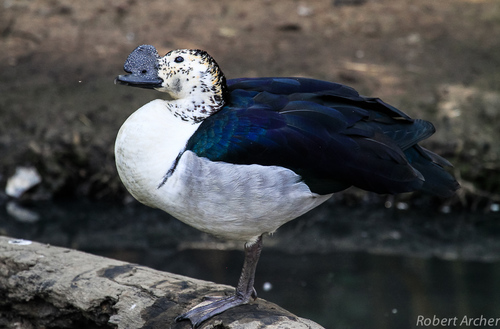
Knob-billed Duck
The Knob-billed Duck (Sarkidiornis melanotos), also known as the Comb Duck, is a striking and unusual waterfowl species found across sub-Saharan Africa, Madagascar, and South Asia. It is notable for the large, fleshy comb on the bill of the male, which becomes particularly prominent during the breeding season. This duck plays a role in its ecosystem as a seed disperser and a consumer of aquatic invertebrates and vegetation. It holds no particular cultural significance that is widely documented, but it's a recognized and appreciated species within its range.
56-76 cm
Length
116-145 cm
Wingspan
Least Concern
Conservation Status
Distribution
Sub-Saharan Africa, Madagascar, India, Sri Lanka, and parts of Southeast Asia. It does not undertake long-distance migrations but may move regionally in response to rainfall and water availability.
Lifespan
Unknown in the wild, but likely similar to other large ducks (potentially 10-15 years).
Knob-billed Duck's Habitat
Habitat Types
Freshwater wetlands, Swamps, Marshes, Lakes, Rivers, Rice paddies
Climate Zones
Tropical, Subtropical
Adaptations
Their broad feet are adapted for walking on floating vegetation, and their bill is suited for grazing on aquatic plants and dabbling for invertebrates.
Variations
Two subspecies are sometimes recognized: *S. m. melanotos* (Africa and Madagascar) and *S. m. sylvatica* (South Asia). The South Asian form is sometimes considered a separate species, the Asian Comb Duck.
Appearance
Breeding Plumage
Males have glossy black upperparts and white underparts. Females are duller, with more mottled brown and buff coloration. The male's comb enlarges during the breeding season.
Seasonal Feather Changes
There is some seasonal variation related to breeding condition, but it is not a dramatic plumage change.
Sex Based Plumage Differences
Significant. Males are larger and more brightly colored, with the distinctive comb.
Notable Features
Large, fleshy comb on the male's bill (especially during breeding), Glossy black and white plumage in males, Dark eyes
Diet and Feeding
Primary Foods
Seeds, Aquatic plants, Grasses, Invertebrates, Small fish, Insects
Foraging Behavior
They graze on vegetation, dabble in shallow water, and occasionally dive to feed.
Specializations
Their bill is adapted for grazing and filtering small food items from the water.
Seasonal Diet Variations
Their diet may shift depending on the availability of food resources. For example, they may consume more seeds during the dry season and more invertebrates during the wet season.
Behavior
Social Structure
Often found in pairs or small groups, but can form larger flocks outside of the breeding season.
Communication
Soft whistles, Grunts, Visual displays (head-bobbing)
Migration
Generally non-migratory, but may undertake local movements in response to water availability.
Territorial or Group Behaviors
Males can be territorial during the breeding season, defending nesting sites and mates.
Conservation
Threats
Habitat loss (wetland drainage), Hunting, Pesticide contamination
Protection Programs
Some protected areas within its range, International agreements on wetland conservation (Ramsar Convention)
Local National Laws
Protected under wildlife legislation in some countries within its range.
Population Trend
Stable
Population Estimates
The global population is estimated to be between 190,000 and 730,000 individuals.
Interesting Facts
The comb on the male's bill is made of a spongy, fleshy tissue.
It becomes enlarged and more prominent during the breeding season, likely playing a role in mate attraction.
They are sometimes called "Comb Ducks" due to the male's distinctive comb.
This is an alternative common name that highlights their most notable feature.
They are generally silent birds outside of the breeding season.
Their vocalizations are primarily used for courtship and communication during breeding.
Faqs about Knob-billed Duck
What is the purpose of the knob on the male's bill?
The knob, or comb, is thought to play a role in mate attraction, becoming larger and more prominent during the breeding season.
Are Knob-billed Ducks migratory?
They are not long-distance migrants, but they may move locally in response to changes in water levels and food availability.
What do Knob-billed Ducks eat?
They have a varied diet that includes seeds, aquatic plants, grasses, invertebrates, small fish, and insects.
Copyright @ Nature Style Limited. All Rights Reserved.
 English
English